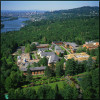Wildfire
Be Aware
If your home is near a forest, prairie, valley or hillside you need to take wildfire very seriously. Wildfires, when forced along a path of dry vegetation by high winds move rapidly, often destroying everything in its path within a few minutes.
As a veteran firefighter working the Oakland-Berkeley Hills fire reported, "I watched the fire progress one hundred yards in fifteen seconds!"
Prepare
Promote a positive fire prevention attitude by following preventive measures now.
To see how well your home is safeguarded, check through the following list.
- Roofing is made of noncombustible material.
- Fire officials report that untreated wood shake roofs, which can catch wind-blown sparks, are the number one cause of home losses in wildland areas. Roofs should be of fire resistant materials, such as asphalt-rag-roll roofing, tile, slate, cement shingle, sheet metal or aluminum.
- Note: Oregon law now gives homeowners living in designated "wildfire hazard zones" the right to replace their cedar roofs with fire resistant materials even if deed restrictions state otherwise. These zones are determined by the State Forestry Department and declared by the governmental agency having jurisdiction over the area. Check with your local fire department to find out if you live in a designated "wildfire hazard zone."
- Trees have been trimmed away from the roof.
- Trim large trees near your home eliminating limbs that hang over your home or garage roof. Large trees should be planted at least ten feet from the outer walls of your home. If you see tree branches contacting power lines, call your local utility. Electrical service lines leading from the main power line to houses or outbuildings start many fires.
- Plants are low-growing and less flammable.
- A well-pruned and watered landscape around your home will serve as a fire line decreasing the possibility that a wildfire will reach your home. Plant trees and bushes sparsely to avoid a path of fuel for the wildfire. Plant less flammable tree and plant species. Hardwoods are less flammable than pine, fir or other conifers.
- Consult your county extension service for more information.
- Flammables are stored away from the home.
- Heat from a burning wood pile can be intense. Pile firewood away from the side of your home at a safe distance. Do not stack wood downhill - fires often travel uphill.
- Yard is well-trimmed and free of debris.
- Avoid providing fuel to a wildfire by keeping shrubs and trees trimmed. Haul away or burn yard debris in a timely manner. Follow local burning regulations and safety precautions when eliminating debris.
- Maintain a 30 foot defensible space around your home to act as a fire break. Additional clearing is necessary if you live on a hillside and/or are surrounded by heavy forest lands.
- Clean your gutters regularly of combustible materials such as pine needles and leaves.
- An adequate water supply is available to fight fire.
- Water sources can include filled cisterns (large water tanks) standpipes or fire hydrants, or wells with high volume pumps. With a portable pump you can also use water from swimming pools, nearby ponds and storage tanks. Acquire an alternate power supply for your well. If the electricity is off, the pump in your well will not help. Keep at least one hose with a nozzle connected to an exterior water outlet at all times. Hoses should be long enough to reach the entire exterior of your home.
- Good access Is provided for emergency vehicles.
- Maintain two-way roads with parking lanes to allow fire trucks and emergency vehicles plenty of room to get in and out; and since these vehicles may have difficulty climbing steep roads, build your road with a slope of less than 10 feet per 100 feet. Clear brush and other flammable materials a full 60 feet wide along your road right-of-way before it becomes a wildfire hazard.
- Exterior walls are made of fire resistant material.
- Choose materials such as brick, stone, aluminum or treated wood products. If you plan to build a home near a wildland area, contact the Oregon Department of Forestry for FIRESAFE recommendations.
Respond
Fight or Flee? in remote areas it may be up to you to put out small fires before they spread. Prepare for this likelihood now by completing these steps.
- Know how to contact your local fire fighting agency.
- Decide where you would go and what you would take if you have to evacuate.
- Plan at least two escape routes by car and another by foot.
- Have a ladder available that is long enough to reach the roof.
- Have fire tools handy: long-handled round-point shovel, rake, axe, chainsaw and a 2 1/2 gallon water bucket.
This information has been provided to you by the American Red Cross with excerpts from the Home Protection Guide provided by the Oregon Department of Forestry.
Campus Safety is located in Campus Safety on the Undergraduate Campus.
MSC: 107
email safety@lclark.edu
voice 503-768-7855
fax 503-768-7195
Emergency 503-768-7777
Alternate Phone 503-593-5457
Director Jay Weitman
Campus Safety
Lewis & Clark
615 S. Palatine Hill Road MSC 107
Portland OR 97219
